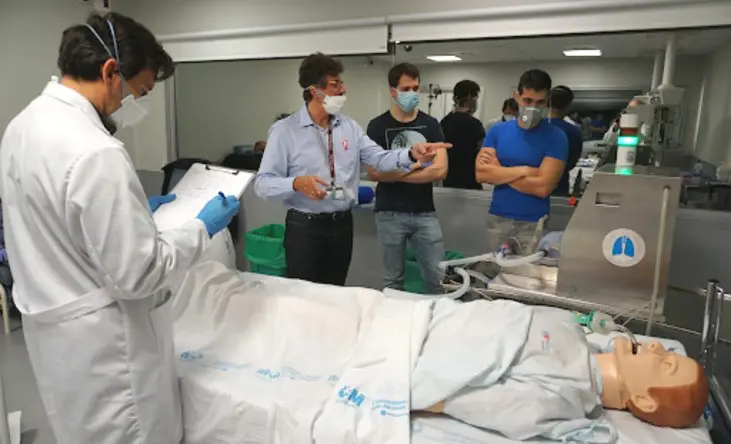HEALTH | 04.28.2020
Interview with Javier González, Materials Engineer and founder of The Open Ventilator
“Our goal is that no person, anywhere in the world, will die because of not having a ventilator.”
The scientific community warns that with #COVID-19 we face a disease that can attack almost any part of the body when it reaches advanced stages but, in the vast majority of cases, the lungs are the ground zero of the battle. This is why patients with a worse case of the condition often require mechanical assistance to breathe. In an unprecedented context of global demand for medical materials, these devices, which have been used for a long time, have become a precious and scarce commodity. We talked to Javier González, a Materials Engineer and founder of The Open Ventilator — a project that receives financing from Fundación MAPFRE to produce an apparatus model equivalent to approved commercial ventilators that will allow this resource to be available to all.
Which different specialists are involved in the design of this ventilator?
The Open Ventilator came about because of concerns over a serious supply problem with ventilators in Spain. That’s why a first concept idea was developed, to see if we could create a ventilator that would help save lives. Javier Asensio, a Doctor at the Hospital 12 de Octubre in Madrid, immediately joined this project. To make further progress, we contacted Celera, a network of young talent, and the Rey Juan Carlos University, who decided to support us. From there, different people from different specialized fields—including electronic engineers, computer technicians, graphic designers and legal specialists—have been joining. These people are absolutely critical in providing range for this huge project.
How do ventilators work?
They are basically devices that generate a controlled, pressurized flow of air to allow the lungs to inflate, similar to how we would inflate a balloon. When a flow is generated in a patient, it must be controlled and two variables must be assessed. On the one hand, the speed and volume of that flow and, on the other hand, the pressure at which it is expelled. The measurement of both variables is essential for the physician because each one provides different information. As a result, there are several ventilation modes, which can be split into two groups: volume control and pressure control. When controlling the volume, the aim is to guarantee a minimum volume, i.e. a minimum amount of air reaching the lungs to ensure proper ventilation. However, there are other situations in which it is more of interest to control the pressure exerted. Ventilators are used a lot with patients suffering from COVID-19, as the disease generates significant respiratory stress, causing the lungs to become stiff and fragile. This requires a very high minimum pressure and very low maximum pressure to be able to keep the lung relaxed in order to obtain proper ventilation and avoid excessive pressure, and therefore more lung damage. Here lies the importance of being able to ventilate not only through a volume control mode but also through a pressure control mode.
How does this model differ from others that are already on the market?
It is not in our interests to compare ourselves with anyone, because any help in the fight against the pandemic is to be welcomed. That said, the main feature of The Open Ventilator device is that it meets the health specifications to ensure intubation safety, being able to regulate all kinds of patient parameters and needs, such as respiratory rate, volume and air humidity. To this end, it has numerous sensors and components such as flowmeters, pressure control, filters, humidifiers, control mechanisms and alarm systems with redundant safety systems, in order to meet the safety and efficacy criteria required by current legislation. It also has a machine learning sensor that allows it to learn and adjust to medical needs in real time. All of this has allowed it to pass comprehensive fatigue, electromagnetism and in vivo testing and it is now waiting to finally pass a clinical trial with patients. In this way, once the pandemic has been overcome, we are looking to get it approved with the CE mark, following the established procedure and complying with all medical standards.
But the first approval has already been granted, right? What are the next steps?
The Open Ventilator’s ventilator was the first of the projects launched in Spain to receive approval to combat coronavirus urgently, but not the only one. Our next steps are to obtain validation from hospitals. The ventilator has successfully passed tests performed in a simulation environment to make small optimization adjustments to enable the research teams to assess the inclusion of patients in the clinical trial, based on the logistical conditions of each healthcare facility, in accordance with the strict requirements of the AEMPS (Agencia Española de Medicamentos y Productos Sanitarios — The Spanish Agency of Medicines and Medical Devices). The trial will also be extended to other Latin American hospitals. In the meantime, scale production has already started, with our next goal being to reach the first 250 units in the coming weeks, mainly for Latin America.

How is the medical community receiving your work?
With the prototype having advanced to a more robust and functional ventilator, a host of hospital organizations have been willing to support the project because of the saturation of seriously ill patients in ICUs. This interest has now shifted, as I said earlier, to Latin American countries where COVID-19 is beginning to hit hard.
How important is private company involvement in research? What does the involvement of Fundación MAPFRE mean?
Without the first private financial contributions by members of Celera, and especially the unconditional support of Fundación MAPFRE, it would have been impossible to push forward this wonderful Spanish R&D project. While the entire team works on a non-profit basis, one thing is for certain — the necessary components are as expensive as they are difficult to find. Therefore, without the support of Fundación MAPFRE, as well as the disinterested contributions of thousands of people, the support of the Community of Madrid and the industrial sector of companies, the project could never have moved forward.
What production capacity could you have? How many patients in need of a ventilator could be reached?
The main objective right now is to have the first 50 ventilators as soon as possible at the cost of the materials, of which the first will be distributed in Spain to carry out definitive tests on humans and 40 will be delivered to Fundación MAPFRE for donation to various hospitals. Production will then be expanded to 25 per week, with the capacity to increase it to 25 per day if necessary. The goal is that no person, whether in Spain, Latin America or anywhere in the world, will die because of not having a ventilator.
Solidarity has driven this project from the very beginning, and that also implies difficulties.
The entire The Open Ventilator team—some 70 people around the world—is working on a non-profit basis in order to help healthcare services to save lives and so that no one, as far as possible, will be abandoned because of the lack of ventilators. This implies a huge effort of coordination, decision-making and internal communication. A whirlpool of work that sometimes causes us to forget to be grateful for the immense effort made by each and every member of the team. We often eat badly and have many nights of insomnia.
Thank you for the work you are doing for all of society!

